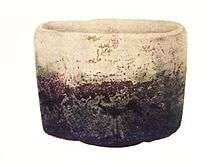Kinrande
Kinrande (金襴手 , literally "gold brocade") is a Japanese porcelain style where gold is applied on the surface. There are a number of various styles. It originated from China during the Jiajing (1577-1566) and Wanli (1573-1620) periods of the Ming dynasty.[1][2][3]
.jpg)
In the late Edo period, Arita ware, Imari ware, Kotō ware,[4] Kutani ware, Kyō ware and Satsuma ware had pieces in this style.[5][6] Imari pieces in kinrande style were particularly popular in Baroque era Europe, amongst the foremost collectors being King Augustus II the Strong of Poland.[7]
Typically, gold was added to Chinese wucai (五彩) palette, called gosai in Japanese, which had a white base with red, green and yellow motifs. Other types of kinrande include:[8]
- multi-colored motifs and gold on a white base (赤絵金襴手 akae kinrande)
- red base, multi-colored motifs and gold (赤地金襴手 akaji kinrande)
- green base (緑地金襴手 ryokuji kinrande)
- yellow base (黄地金襴手 ouji kinrande)
- celadon base (白地金襴手 hakuji kinrande)
- emerald base (瑠璃地金襴手 ruriji kinrande)
- blue-and-white base (染付金襴手 sometsuke kinrande)
- tricolour base (三彩金襴手 sancai kinrande)
One of the artists specialising in kinrande was Jiro Ono (小野次郎, Ono Jiro) (1953-2010), the second son of Hakuko Ono (小野珀子, Ono Hakuko), herself a renowned artist of yūri-kinsai.[9][10][11]
References
- http://www.aisf.or.jp/~jaanus/deta/k/kinrande.htm
- http://gotheborg.com/glossary/kinrande.shtml
- https://www.suntory.com/sma/exhibition/2014_1/display.html
- http://www.pref.aichi.jp/touji/collection/08/collection/85.html
- http://www.aisf.or.jp/~jaanus/deta/k/kinrande.htm
- http://gotheborg.com/glossary/kinrande.shtml
- https://www.suntory.com/sma/exhibition/2014_1/display.html
- http://www.aisf.or.jp/~jaanus/deta/k/kinrande.htm
- http://www.japanpotterynet.com/en/user_data/artist151.php
- http://www.japanpotterynet.com/en/user_data/kilns149.php
- https://www.youtube.com/watch?v=gRQ7yxf6V-M
